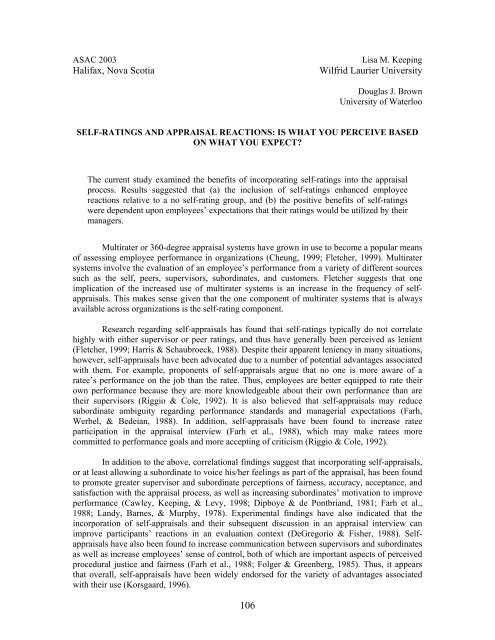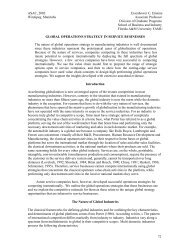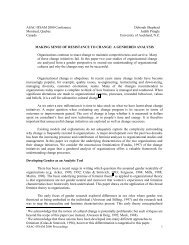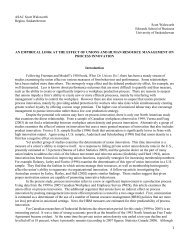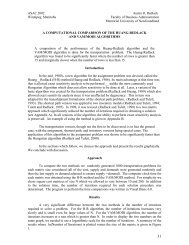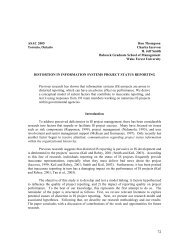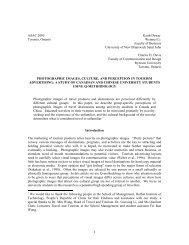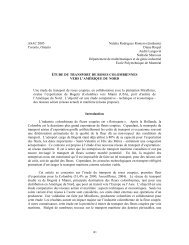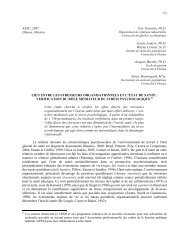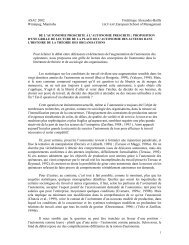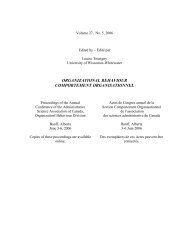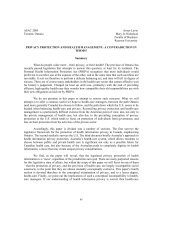ASAC 2003Halifax, Nova ScotiaLisa M. KeepingWilfrid Laurier UniversityDouglas J. BrownUniversity of WaterlooSELF-RATINGS AND APPRAISAL REACTIONS: IS WHAT YOU PERCEIVE BASEDON WHAT YOU EXPECT?The current study examined the benefits of incorporating self-ratings into the appraisalprocess. Results suggested that (a) the inclusion of self-ratings enhanced employeereactions relative to a no self-rating group, and (b) the positive benefits of self-ratingswere dependent upon employees’ expectations that their ratings would be utilized by theirmanagers.Multirater or 360-degree appraisal systems have grown in use to become a popular meansof assessing employee performance in organizations (Cheung, 1999; Fletcher, 1999). Multiratersystems involve the evaluation of an employee’s performance from a variety of different sourcessuch as the self, peers, supervisors, subordinates, and customers. Fletcher suggests that oneimplication of the increased use of multirater systems is an increase in the frequency of selfappraisals.This makes sense given that the one component of multirater systems that is alwaysavailable across organizations is the self-rating component.Research regarding self-appraisals has found that self-ratings typically do not correlatehighly with either supervisor or peer ratings, and thus have generally been perceived as lenient(Fletcher, 1999; Harris & Schaubroeck, 1988). Despite their apparent leniency in many situations,however, self-appraisals have been advocated due to a number of potential advantages associatedwith them. For example, proponents of self-appraisals argue that no one is more aware of aratee’s performance on the job than the ratee. Thus, employees are better equipped to rate theirown performance because they are more knowledgeable about their own performance than aretheir supervisors (Riggio & Cole, 1992). It is also believed that self-appraisals may reducesubordinate ambiguity regarding performance standards and managerial expectations (Farh,Werbel, & Bedeian, 1988). In addition, self-appraisals have been found to increase rateeparticipation in the appraisal interview (Farh et al., 1988), which may make ratees morecommitted to performance goals and more accepting of criticism (Riggio & Cole, 1992).In addition to the above, correlational findings suggest that incorporating self-appraisals,or at least allowing a subordinate to voice his/her feelings as part of the appraisal, has been foundto promote greater supervisor and subordinate perceptions of fairness, accuracy, acceptance, andsatisfaction with the appraisal process, as well as increasing subordinates’ motivation to improveperformance (Cawley, Keeping, & Levy, 1998; Dipboye & de Pontbriand, 1981; Farh et al.,1988; Landy, Barnes, & Murphy, 1978). Experimental findings have also indicated that theincorporation of self-appraisals and their subsequent discussion in an appraisal interview canimprove participants’ reactions in an evaluation context (DeGregorio & Fisher, 1988). Selfappraisalshave also been found to increase communication between supervisors and subordinatesas well as increase employees’ sense of control, both of which are important aspects of perceivedprocedural justice and fairness (Farh et al., 1988; Folger & Greenberg, 1985). Thus, it appearsthat overall, self-appraisals have been widely endorsed for the variety of advantages associatedwith their use (Korsgaard, 1996).106
Although the above noted benefits of self-appraisals have been regarded as intuitivelyplausible, there have been few experimental investigations of these effects (Campbell & Lee,1988) and even fewer field investigations (Cawley, et al., 1998). In fact, in a meta-analysisexamining participation in performance appraisal, Cawley et al. uncovered only one publishedfield study investigating self-ratings as a form of participation. Given the “paucity of fieldexperiments investigating self-ratings” (Cawley et al., 1998, p.626), many of the potentialbenefits of self-appraisals can only be regarded as speculative (Roberson, Torkel, Korsgaard,Klein, Diddams, & Cayer, 1993). That is, because most of the research involving self-appraisalslacks the comparison of a self-rating group to a control group who does not self-rate, it is difficultto draw any causal conclusions regarding the effect of self-ratings. Thus, one of the primarypurposes of the present study is to investigate some of the perceived advantages of self-appraisalsby directly comparing the reactions of employees who are asked to self-appraise with employeeswho are not. A second purpose of the current study is to better understand the factors that maylead to positive reactions among employees who have self-appraised. On this issue we considerthe possible role of employee expectations regarding the use of their self-ratings, as well as therole of voice.To establish a context within which to view the current paper we will first review theextant literature on performance appraisal reactions and self-ratings. Next, we will discussrelevant research findings on the role of expectations and voice. Finally, we present the resultsfrom an investigation of employees from a large international organization and discuss theimplications of our findings both in terms of possible directions for future research and designingeffective performance feedback sessions.Performance Appraisal ReactionsPerformance appraisal is an issue of importance to both researchers and practitioners,representing a critical human resource function upon which many organizational decisions arebased. As suggested by Cawley, et al. (1998), past research on performance appraisal hasprimarily focused on rating errors and rating accuracy, while appraisal reactions have beenrelatively neglected. However, many researchers have suggested that employee reactions play avital role in the ultimate success of an appraisal system (e.g., Cardy & Dobbins, 1994; Murphy &Cleveland, 1995) and may predict appraisal success more effectively than the traditionalpsychometric measures (Bernardin & Beatty, 1984).Based on a recent review of the different conceptualizations and operationalizations ofappraisal reactions (Keeping and Levy, 2000), the following reactions were adopted for use in thepresent study: satisfaction with the appraisal session, satisfaction with the appraisal system, theperceived utility of the appraisal, the perceived accuracy of the appraisal, procedural justice (i.e.,perceived satisfaction with procedures), and distributive justice (i.e., perceived satisfaction withoutcomes). These reactions were identified by the authors as among the most prevalent in thefield. Thus, it seemed appropriate to assess them in the current study, given that the focus is onassessing how self-appraisals might affect participants’ reactions.Self-Appraisals of PerformanceAs mentioned previously, there is a lack of experimental research examining the effectsof self-ratings (Campbell & Lee, 1988). Moreover, the few extant experimental studies regardingself-ratings provide little clarification of the effects of self-ratings. For example, in a field study,Roberson et al. (1993) predicted that participants in an experimental condition who were asked toself-appraise would react significantly more favorably to their appraisals than would those in acontrol condition who were not asked to self-appraise. However, results comparing these twogroups indicated that, contrary to expectations as well as to previous correlational findings, the107
- Page 1 and 2:
Volume 24, No. 5, 2003Edited by/Éd
- Page 4 and 5:
Pursey HeugensGreg IrvingRoderick I
- Page 6 and 7:
TABLE OF CONTENTS - TABLE DES MATI
- Page 8 and 9:
study of power displays in mixed-ge
- Page 10 and 11:
on expectations and behaviour (Berg
- Page 12 and 13:
TaskThis study required the use of
- Page 14 and 15:
Task-Gender (male-stereotyped or fe
- Page 16 and 17:
It is important to understand the s
- Page 18 and 19:
Crown, C.L. & Cummins, D.A. (1998).
- Page 20 and 21:
Smith-Lovin, L., & Brody, C. (1989)
- Page 22 and 23:
Table 2Summary of Descriptive Stati
- Page 24 and 25:
Table 4Summary of Interaction of Ge
- Page 26 and 27:
ASAC 2003Halifax, Nova ScotiaIain L
- Page 28 and 29:
the interrelationships among the MB
- Page 30 and 31:
studies (Friedman and Sarros, 1989;
- Page 32 and 33:
This study demonstrated that emotio
- Page 34 and 35:
Anxiety, Stress and Coping, in pres
- Page 36 and 37:
Washington, DC: Taylor and Francis,
- Page 38 and 39:
Table 2Overall Goodness-of-Fit Indi
- Page 40 and 41:
ζ 3Depersonalizationη 3β 3,1 (+)
- Page 42 and 43:
ASAC 2003Halifax, Nova ScotiaWendy
- Page 44 and 45:
views independently, gave rise to S
- Page 46 and 47:
track assistant, associate, and ful
- Page 48 and 49:
ole conflict are positively related
- Page 50 and 51:
Table 3. Regression of climate and
- Page 52 and 53:
interests.We speculate the null eff
- Page 54 and 55:
DOOP and short for DOOP scales,”
- Page 56 and 57:
Pelled, L. H., “Demographic diver
- Page 58 and 59:
esulting increase in discretion ove
- Page 60 and 61:
al., 1995). However, the distinctio
- Page 62 and 63: ise to strong pressures for conform
- Page 64 and 65: presented with a complete list of a
- Page 66 and 67: Table 3QAP Regression Coefficients
- Page 68 and 69: ConclusionResearchers of social inf
- Page 70 and 71: suggestions for further research.
- Page 72 and 73: performing on the job.” Presumabl
- Page 74 and 75: positively related to performance i
- Page 76 and 77: proposed hypotheses were supported.
- Page 78 and 79: ConclusionThis research has made se
- Page 80 and 81: Be more enthusiastic and exert extr
- Page 82 and 83: Table 2Correlations Among the Laten
- Page 84 and 85: performance expectations on feedbac
- Page 86 and 87: changements qui s’opèrent dans l
- Page 88 and 89: structures, politiques, systèmes,
- Page 90 and 91: comportements liés à la communica
- Page 92 and 93: Tableau 2Échelles de mesure de la
- Page 94 and 95: prédiction des compétences clés
- Page 96 and 97: organisation n’est pas uniforme e
- Page 98 and 99: complètement ce construit. Ces cha
- Page 100 and 101: Wagner, R.K. and Sternberg, R.J. (1
- Page 102 and 103: What is a toxin handler?In two arti
- Page 104 and 105: potentially limited scope and conte
- Page 106 and 107: work role demands. In this survey,
- Page 108 and 109: The three factors in this rotated f
- Page 110 and 111: and service orientation, the abilit
- Page 114 and 115: self-appraisal group reacted more n
- Page 116 and 117: effect of voice are the value-expre
- Page 118 and 119: “Strongly Disagree” to “Stron
- Page 120 and 121: esults suggest that incorporating s
- Page 122 and 123: Personality and Social Psychology,
- Page 124 and 125: Table 1Means, Standard Deviations,
- Page 126 and 127: Table 3Test of the Mediating Role o
- Page 128 and 129: ASAC 2003Halifax, Nova ScotiaAnn Fr
- Page 130 and 131: individual level, polychronicity is
- Page 132 and 133: construct.Drawing on computer-media
- Page 134 and 135: Consequence: Impact on Work Overloa
- Page 136 and 137: Conversation complexity may also mo
- Page 138: Implications for practiceFuture res
- Page 141 and 142: ReferencesAncona, D.G., Goodman, P.
- Page 143 and 144: no. 3 (1994): 381-391.Macan, T.H.,
- Page 145 and 146: ASAC 2003Halifax, Nova ScotiaIan R.
- Page 147 and 148: Assessing Measures: Affective Commi
- Page 149 and 150: implications of psychological contr
- Page 151 and 152: commitment, affective commitment, c
- Page 153 and 154: Motivational Process Variables. Amo
- Page 155 and 156: DiscussionThe main purpose of this
- Page 157 and 158: approaches zero. In the present stu
- Page 159 and 160: Extension and test of a three-compo
- Page 162 and 163:
Table 1Descriptive Statistics and Z
- Page 164 and 165:
Table 3Standardized Factor Loadings
- Page 166 and 167:
Table 5Hierarchical Regression Anal
- Page 168 and 169:
ASAC 2003Halifax, Nova ScotiaJoan F
- Page 170 and 171:
ASAC 2003Halifax, Nova ScotiaArla D
- Page 172 and 173:
ASAC 2003Halifax, Nova ScotiaIvy Ky
- Page 174:
ASAC 2003Halifax, Nova ScotiaNina D


